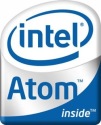Intel spins new Atom for netbooks
Jan 14, 2009 — by LinuxDevices Staff — from the LinuxDevices Archive — 1 views Intel has leaked details of a new Atom processor and chipset, aimed squarely at the hot netbook market. The new 1.66GHz N280 will be accompanied by a northbridge/southbridge known as the GN40, possibly combined into one chip in order to extend battery life.
Intel has leaked details of a new Atom processor and chipset, aimed squarely at the hot netbook market. The new 1.66GHz N280 will be accompanied by a northbridge/southbridge known as the GN40, possibly combined into one chip in order to extend battery life.
According to Intel, its new Atom N280 will be a single-core, single-threading processor built using the chipmaker's 45nm High-k technology. The company cites a 1.66Ghz clock speed, 533MHz frontside bus, and 512K of second-level cache.
With the exception of a tiny .06GHz boost in speed, these figures are identical to those for the 1.6GHz N270 that's already wildly popular in netbooks, so you may be wondering what the point of the new CPU is. Intel hasn't said — but third-party reports suggest that the N280's key feature could be its use of a new northrbridge/southbridge companion chip known as the GN40. As we'll explain later in this story, such a component could be key to extending the battery life of netbooks, while keeping costs down.
A story published earlier today in the Taiwanese publication Digitimes claims notebook vendors such as Asus, Acer, and Gigabyte will release laptops based on the N280/GN40 combo as early as the second quarter. However, neither Intel nor Digitimes has offered any further background on the GN40, nor confirmed whether it comprises one chip or two.
Some rumors suggest that the GN40 will tackle hardware video decoding, allowing Atom-powered devices to display 1080p HD video for the first time. However, it's also possible that the new chipset and processor are primarily an attempt to cut power consumption.
Either way, the new CPU will disappoint those who were hoping for faster netbook performance. Intel launched a dual-core Atom 330, targeting low-cost desktop PCs, but has as yet shown no sign of following up with a netbook equivalent.
Background
Intel first released its Atom processors — targeting low-cost devices that previously used its Celeron — in April of last year. The initial Z5xx series of Atoms, also known as “Silverthorne,” features a 13 x 1mm package, clock speeds from 800MHz to 1.86GHz, and a northbridge/southbridge companion chip known as the SCH US15W (aka “Poulsbo”).
The second series of Atoms, announced in June 2008, includes the N270 and 230, aka “Diamondville.” Architecturally identical to the Z5xx series, these are 22 x 22mm CPUs that were designed to be more affordable. Hence, they rely on separate northbridge and southbridge chips — Intel's 945GSE is commonly paired with the N270; the 945GC with its desktop cousin.
Since then, of course, the 1.6GHz N270 has become wildly popular in the class of low-cost mini-laptops known as netbooks. But, as manufacturers have sought to extend the battery life of their products, they've bumped up against some limitations. While the N270 itself has a modest TDP of just two Watts, its 945GSE (945GCSE northbridge and 82801GBM southbridge) chipset chews up another six Watts.
To get around this, some manufacturers, including MSI with its U100 and U115, and Dell with its Inspiron Mini 12, have turned to the 1.6GHz Z530. Given that Silverthorne and Poulsbo together use just 4.5 Watts, improved battery life compared to Diamondville obviously results — but at a cost. While the N270 reportedly costs manufacturers around $46, the Z530/SCH US15W solution costs them $95.
According to the Digitimes report referenced above, the N280 and GN40 combo will split the difference in pricing, selling for between $60 and $65 in thousand-unit quantities.
Further information
Intel has not officially released information about the N280, but confirmation of its clock speed, bus speed, second-level cache size, and manufacturing process can be found in a sales document on the company's website, here [PDF link]. To read the Digitimes report referred to in this story, see the publication's website, here.
This article was originally published on LinuxDevices.com and has been donated to the open source community by QuinStreet Inc. Please visit LinuxToday.com for up-to-date news and articles about Linux and open source.